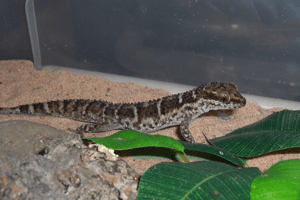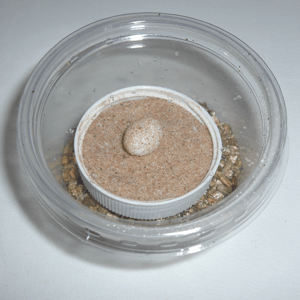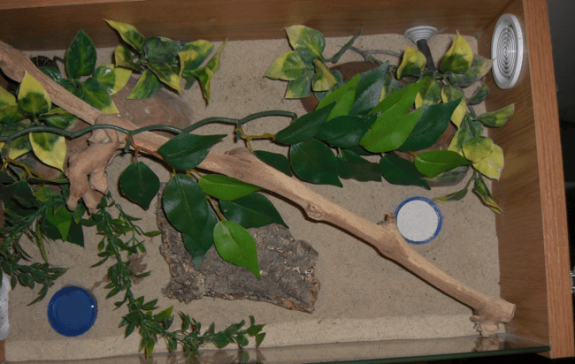The Paraguayan Ground Gecko (Homonata horrida) is a relatively small species that at present is uncommon in the hobby with very little information available. Despite this, the ease of care and low price tag for this species is sure to see its popularity grow as more become available.
First Encounter
My first encounter with these was when I visited a gecko breeder here in the UK, who I’ve known for some time, to collect a new Goniurosaurus luii for my collection. I was shown many of the amazing geckos in his possession, but was most taken with these little unusual looking geckos I had never seen before. Needless to say much discussion ensued, and upon ensuring I could meet the care requirements (which are to be honest very simple indeed), I acquired a pair.
The first thing I noticed about them was they took relocation in their stride. I did keep them in their original set up which probably helped the move, but despite the change of location they were undaunted and immediately began devouring everything food-wise offered to them.
This brings me to their complete love of all things food. If it’s bug-shaped and fits in their mouths it’s on the menu. They love speeding around after crickets, mealworms are either eaten from a dish or snatched from the tongs, and roaches gobbled with relish. As with all geckos they require their food to be dusted with supplementation calcium powder; this is especially important for females. A dish of calcium powder should also be made available at all times.
Temperament
Behaviour-wise they are, as with many gecko species, nocturnal and spend a great deal of the day hiding. Despite this however, they are busy little things, and as the daylight fades they emerge in search of food. I have seen that as well as appreciating ground space they like the opportunity to climb a little bit, therefore small branches, rocks and cork bark in the enclosure are appreciated. They also like to burrow if given the chance and if the substrate is something like sand they will dig little burrows under the ornaments. However if the opportunity to burrow is unavailable they do seem perfectly happy with custom made gecko caves or the like.
The temperament of these geckos is skittish. They are swift and flighty and quick to speed around the enclosure when disturbed. They do not like to be picked up or touched. For this reason I would suggest this is a “look at only” species unsuitable for handling, but because they are busy little geckos, they are lots of fun to watch.
As this is a species that has not been worked with much in the hobby there are currently no available morphs. The coloration of my wild type pair differs a lot with the female being light and the male being quite dark which indicates a degree of dimorphism within the existing wild types.
General Care
Regarding care, Paraguayan Ground geckos are very hardy and remarkably easy to keep providing their basic needs are met. Due to their nocturnal nature lighting such as UV is not required, however I am aware of the current debates surrounding UV for nocturnal animals and if you wish to include this lighting during the daylight hours it certainly won’t do them any harm. Like many other geckos they require hot. dry conditions. You need an under tank heat mat that covers approx one third of the total floor space, aiming to create a gradient of 90F (at the hot end) to 73F (at the cool end). Hides should be placed at both the hot and cool ends to give the geckos a chance to thermoregulate. Due to the small size of these geckos (approx five inches from snout to tail tip) the enclosure does not need to be ever so big with as little as 1.5ft by 1ft being adequate for one animal, however providing plenty of ornaments/decor is important since the animals do make use of any amount of space provided to them.
A moist hide is not required for this species; however you should choose an area of the tank to spray lightly every couple of days. This will provide drinking water and also a moister place for shedding. I have also found they do appreciate the availability of a small water bowl with fresh water available at all times.
Substrate is your choice. If you are worried about the dangers of impaction you can use lino, tiles or kitchen towel. Or if you feel happy to do so you can use a substrate such as fine grain play sand (not calci sand). This gives the geckos the chance to burrow and also gives laying females a place to lay (she will bury her eggs in the sand). At the end of the day it comes down to personal choice. I keep them on play sand because they like to dig and burrow and I have had no problems with this. I would however not use sand for hatchlings and instead go with paper towel or the like.
These geckos can be kept in pairs or groups consisting of females or several females to one male, however they can also live separately with no problems. As with any animal community, the situation should be monitored and if any animal appears bullied or stressed the animals should be separated immediately. Males will fight and so should not be kept together.
When it comes to breeding these geckos seem eager to do so. You can put the male with the female and nature will generally take its course. The male will re mate the female regularly, however the female can retain sperm for several months/weeks after a mating so can produce fertile eggs even after the male is removed. The eggs the female produces are hard shelled and really quite large in size when compared to the size of the female. It is probably for this reason that the female produces just a single egg at a time instead of the standard two seen with many gecko species. The clutch size is smaller but the time between eggs is shorter than most geckos with one egg being produced on a weekly basis. Once the female starts to lay she will be like clockwork and the eggs will come fast and reliably.
To incubate the eggs, place them (without turning them) in a small dish filled with sand and then place the sand-filled dish inside a small plastic container which has a slightly moist layer of vermiculite at the bottom. Pop a lid on. Job done.
The previous keeper of these geckos found the eggs hatch at a temperature of 82F in around 50-60 days. I currently have several eggs incubating that look nice and healthy but no hatchlings. It will be interesting to see when the hatchlings make an appearance.
In conclusion, Paraguayan Ground Geckos have proved to be a great alternative, easy to care for, inexpensive gecko species to keep. Not many are available at the moment, but they have a low price tag costing approx £15 for a hatching in the UK. As more captive bred specimens become available I am confident the popularity of this currently little known but interesting and undemanding species will grow.






How can i now if my Paraguayan ground gecko ya male or female?